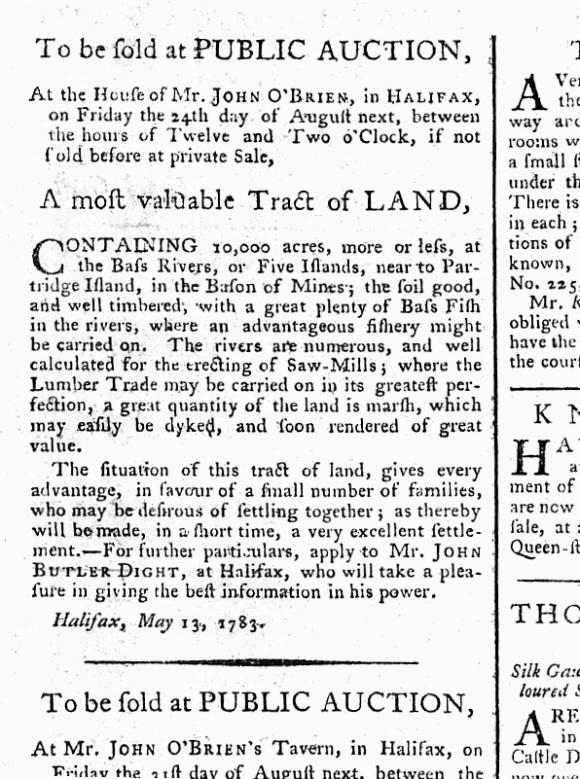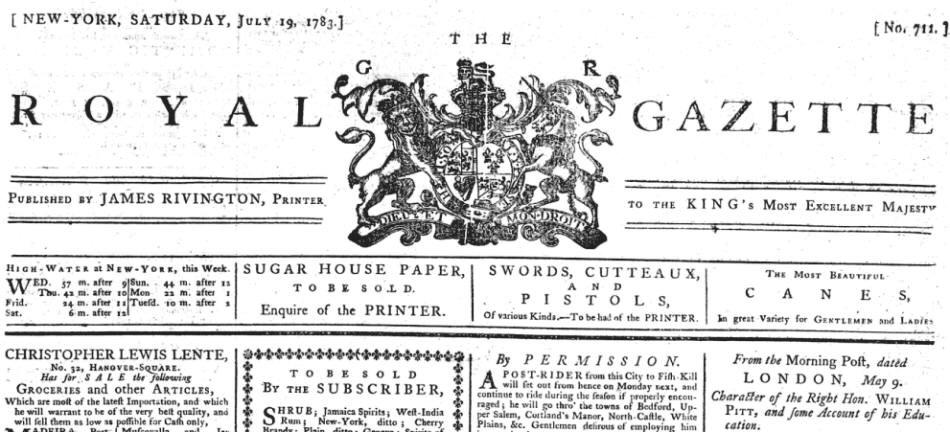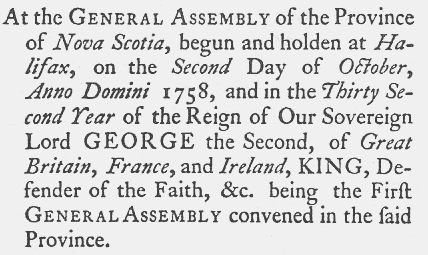
Source: The Royal Gazette, New York, 19 July 1783
Scanned directly from the original newspaper (not from microfilm).
Minas Basin
|
At the House of Mr. John O'Brien, in HALIFAX on Friday the 24th day of August next, between the hours of Twleve and Two o'Clock, if not sold before at private Sale, Containing 10,000 acres, more or less, at the Bass Rivers, or Five Islands, near to Par- tridge Island, in the Bason of Mines; the soil good, and well timbered, with a great plenty of Bass Fish in the rivers, where an advantageous fishery might be carried on. The rivers are numerous, and well calculated for the erecting of Saw-Mills; where the Lumber Trade may be carried on in its greatest per- fection, a great quantity of the land is marsh, which may easily be dyked, and soon rendered of great value. The situation of this tract of land, gives every advantage, in favour of a small number of families, who may be desirous of settling together, as thereby will be made, in a short time, a very excellent settle- ment. — For further particulars, apply to Mr. John Butler Dight, at Halifax, who will take a plea- sure in giving the best information in his power. Halifax, May 13, 1783 as printed in the original newspaper.) |

James Rivington was born about 1724 in London, England, and died in New York City in July 1802.
Rivington's Royal Gazette was printed in New York City during the Revolutionary War, also known as the American War of Independence. Once the British forced Washington off Manhattan in 1776, the area of New York City and Long Island became a magnet for displaced loyalists. New York was occupied continuously by the British throughout the Revolutionary War — until November 1783 when the British army left New York forever. New York was the last city in the United States that was occupied by British forces after the signing of the
Paris Peace Treaty
in September 1783 that ended the war.
On 12 April 1773, Rivington launched his New-York Gazetteer, a weekly newspaper published in New York. This controversial newspaper ended on 23 November 1775, when a party of armed men from Connecticut entered the city on horseback, raided his office, destroyed his press and melted down his type.
Rivington went to England, obtained a new press and type, and resumed publication on 18 October 1777, calling the paper Rivington's New-York Royal Gazette, published twice each week.
The Royal Gazette issue of July 19, 1783 – the issue containing the advertisement copied above – was printed on both sides of a single sheet of paper 60.0cm × 46.0cm (a "broadsheet") folded once to make four pages.
After the departure of the British army from New York on 22 November 1783, Rivington changed the name of his newspaper to Rivington's New-York Gazette and Universal Advertiser, but circulation declined rapidly and the last issue appeared on 31 December 1783.
Reference:
The New York Press and Its Editors
Book 12, Chapter 21, The History of New York State published 1927
Rivington's New-York Gazetteer, or The Connecticut, New-Jersey, Hudson's-River, and Quebec Weekly Advertiser
22 April 1773 - 9 December 1773
Rivington's New-York Gazetteer, or, The Connecticut, Hudson's River, New-Jersey, and Quebec Weekly Advertiser
16 December 1773 - 23 November 1775
Note the subtle name change,
from Gazetteer (above) to Gazette (below).
Rivington's New-York Gazette, or, The Connecticut, Hudson's River, New-Jersey, and Quebec Weekly Advertiser
4 - 11 October 1777
(published on Saturday each week)
Rivington's New York Loyal Gazette
18 October 1777 - 6 December 1777
(published on Saturday each week)
The Royal Gazette
13 December 1777 - 19 November 1783
Rivington's New-York Gazette and Universal Advertiser,
22 November 1783 - 31 December 1783

|
...Realizing that to stay [in New York] would imperil their lives, the loyalists appealed to the British government to find them homes elsewhere. Some were allowed to go to England, others went to the West Indies, but by far the greatest number were shipped to Nova Scotia. "Hell or Halifax," they shouted defiantly as their transports set sail from New York harbor. "Nova Scarcity," the patriots shouted after them, rejoicing that their enemies were bound for a cold, barren coast and were leaving behind pleasant homes and fertile lands. "The country counties have engaged many months ago, to hold the Toryes banished," wrote a Fishkill citizen in a letter published in the New York Morning Post on November 7, 1783; "the voice of the inhabitants is so universally against them that they cannot hope for a peaceful residence among us." And in the same issue of the Post appeared a burlesque of a Hamlet soliloquy beginning:
To go–or not to go–is that the question?
of a considerable part of the Hudson River civilization. More than twenty-eight thousand refugees, many of them residents of the New York region, left for Canadian ports in that year alone... — Exerpted from chapter 12 of The Hudson, by Carl Carmer, published by Farrar and Rinehart, New York, 1939, (one of a series of books on the rivers of the United States). Chapter 12 deals with the "Removal of the Hudson River Toryes to Nova Scotia". In the early 1780s, when it had become clear to everyone that the Thirteen Colonies had succeeded in breaking away from Great Britain, the choices facing Loyalists living along the Hudson River valley were fully as bleak as described by Carmer. Source: http://ulster.net/~hrmm/diglib/carmer/chapter12.html |
|
The Hudson by Carl Carmer Rivers of America Series Published: New York, Farrar & Rinehart, 1939 Archived: 2002 October 20 http://web.archive.org/web/20021020090941/ulster.net/~hrmm/diglib/carmer/carmer.html Archived: 2003 June 16 http://web.archive.org/web/20030616234445/http://ulster.net/~hrmm/diglib/carmer/carmer.html Archived: 2004 February 15 http://web.archive.org/web/20040215000431/http://www.ulster.net/~hrmm/diglib/carmer/carmer.html |
|
In the above land-for-sale ad, there appear to be several spelling mistakes: fold houfe Bafs Fifh marfh fmall foon sold house Bass Fish marsh small soon These look like the typesetter repeatedly confused the letter 'f' for 's', but they are not mistakes. [Note: The letter f has been used here to represent the 27th letter, which is not available in modern fonts and cannot be accurately reproduced in this commentary. The modern letter f resembles, but is not identical to, the 27th letter.] They are examples of an old-style spelling that was a well-known usage in the 1700s when these ads were set in type, but which disappeared completely in the mid-1800s. In modern times, our alphabet has 26 letters, and most people are unaware that there ever were more than the familiar 26. the English alphabet contained 27 letters. The standard English alphabet used in those days in Nova Scotia and throughout English-speaking North America, and in Great Britain and throughout the British Empire, had a letter that has now disappeared from the alphabet. This "extra" letter, correctly used at the time, is what makes the spelling of these two words look odd now. The 1783 spellings used the letter called the long-s. Up till the mid-1800s, the long-s was used for s at the beginning and in the middle of words. In Roman type the long-s looks like an f with the cross-stroke on the left only, and in italic type it looks like a stretched round s. 
If a word ended in a single s, the short form was used. If a word ended in double s, a long form followed by a short form was used. If the word had a double s in the middle, one used either two long forms or a long form followed by a short one. The following is an example from the statutes of Nova Scotia, printed in Halifax in 1758. In this text, compare the 'f' in 'Defender' with the 'long-s' in 'Fir∫t' (First) and in '∫aid' (said). Note that the two letters are similar in shape, but in the 'long-s' the right side of the crossbar is omitted. [Note: Modern fonts do not include either form of the long-s. The symbol ∫ has been used here to represent the long-s, this being as close as I can get to the correct symbol. Some browsers may not recognise this symbol; these will print a question mark in its place.] 
"...being the First General Assembly convened in the said province." First page of the Nova Scotia Statutes of 1758 Source: The Legislative Assembly of Nova Scotia 1758-1983: A Biographical Directory edited and revised by Shirley Burnham Elliott, ISBN 088871050X published 1984 by the Province of Nova Scotia The long-s began to disappear from printed documents in the 1790s, and printed examples are rare after about 1820. The long-s continued to appear in handwritten documents for some years after it disappeared completely from printed documents, no doubt because people who had learned to write that way continued the usage as long as they lived. The Straight Dope on the Long S http://www.straightdope.com/classics/a1_110.html Why did 18th-century writers use F inftead of S? Who finally put an end to this abfurd practice? The use of 'f' in the place of 's' in early English writing http://www.linguistlist.org/~ask-ling/archive-2000.1/msg00478.html Why does 's' look like 'f' in old books? http://www.alphalink.com.au/~umbidas/why_does_f.htm When you look for the first time at a book or newspaper that was printed in the 1700s, you see strange looking lower case 's' letters. They look like 'f'. However, if you look closely, you can see that they don't have a complete cross-stroke as in 'f'. They evolved from the way 's' was written in Old English, with a long descending stroke. How to Read 18th Century British-American Writing ...The lower case s was written in elongated form at the beginning of a word, in the middle of a word, and when written twice, as in pass. The elongated s can be mistaken for an f, and ss can look something like a p... |